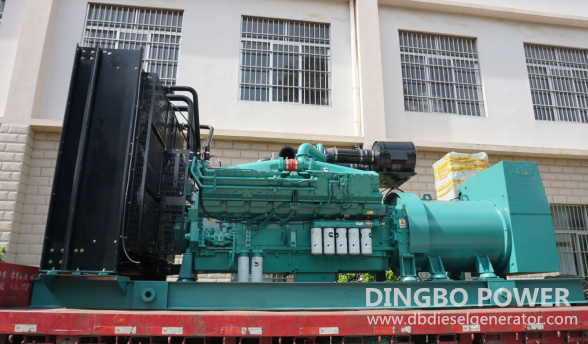dingbo@dieselgeneratortech.com
+86 134 8102 4441

- Home
- Products
- About Us
- Service
- News
- Technical Support
- Contact Us
dingbo@dieselgeneratortech.com
+86 134 8102 4441
Aug. 04, 2025
Abnormal fuel return in the Cummins QSK38 engine typically manifests through various observable fault symptoms. The root causes are often related to fuel line blockage, fuel injection system maladjustment, sensor failure, or issues with the Electronic Control Module (ECM). The following analysis outlines typical fault phenomena and targeted solutions based on technical principles:
Phenomenon: No smoke or minimal white smoke from exhaust during cranking; multiple failed engine start attempts.
Cause: Blocked return line preventing fuel circulation, or poor injector atomization affecting combustion efficiency.
Phenomenon: Insufficient power under high load; delayed throttle response.
Cause: Faulty fuel pressure regulator or clogged injector nozzles leading to lean air-fuel mixture (A/F ratio imbalance).
Phenomenon: Persistent black smoke (incomplete combustion) or white smoke (unburned fuel vaporization).
Cause: Injector dribble, excessive return fuel volume, or failed oxygen sensor causing erroneous fuel injection correction.
Phenomenon: Significant increase in fuel consumption; reduced operating range.
Cause: Leaking (failing to seal) return valve or faulty pressure regulator, allowing unburned fuel to return directly.
Phenomenon: Instrument cluster shows excessive oil temperature; noticeable increase in engine operating noise (metal friction sound).
Cause: Restricted return flow leading to insufficient lubrication, exacerbating friction in components like pistons and crankshafts.
Phenomenon: RPM fluctuation at idle, accompanied by chassis resonance.
Cause: Uneven fuel injection across cylinders or abnormal ECM control signals (e.g., master/slave ECM communication fault).

Operations:
Check fuel tank level and fuel quality; eliminate water or contaminant contamination (drain water or replace fuel).
Test hand primer pump pressure; replace fuel pump or clean fuel-water separator filter element if suction is insufficient.
Replace suspect lines with transparent pressure-resistant tubing to visually identify blockage points.
Tools: Pressure gauge, hand primer pump.
Operations:
Injector testing: Perform cylinder cutout test using Cummins INSITE software to check injection uniformity per cylinder; disassemble and inspect abnormal injectors for atomization quality and return volume.
Injection pump calibration: Calibrate injection timing and pressure on a test bench (standard pressure differential ≤ 100 bar).
Replacement Recommendation: Severely clogged or leaking injector nozzles require complete replacement.
| Key Component | Fault Impact | Testing Method |
| Air Flow Sensor | Incorrect A/F ratio calculation, lean mixture | Read data stream via ECM; compare to standard values |
| Oxygen Sensor | Failed exhaust oxygen content feedback | Check if voltage signal fluctuates between 0.1–0.9V |
| Master/Slave ECM Comm. | Interrupted fuel injection control signal | Check CAN bus communication status with diagnostic tool |
Action: Replace failed sensors; reset ECU parameters.
Operations:
Check fuel pressure regulator diaphragm seal integrity; confirm return valve opens/closes freely.
Clean or replace sticking return valve; ensure fuel pressure stabilizes at 300–500 kPa (refer to QSK38 Technical Manual).
Operations:
Clean carbon deposits from valves and intake ports; repair intake manifold leaks (use aerosol cleaner to detect leaks).
Measure cylinder compression; adjust valve clearance to standard value (cold clearance 0.38–0.43 mm).
Regular servicing: Replace diesel fuel filter every 500 operating hours; clean injectors and fuel lines every 1000 operating hours.
Fuel management: Use low-sulfur diesel fuel conforming to Cummins Standard CES 20081 to avoid gum/varnish deposits.
Electronic system monitoring: Connect INSITE software monthly to read fault codes for early warning of ECM or sensor anomalies.
Note: If the fault persists and is accompanied by ECM communication alerts (e.g., fault codes 228/229), professional servicing of the dual ECM coordination module is required. Avoid self-disassembly to prevent program lockout.
Through the above systematic troubleshooting and maintenance, the QSK38 engine fuel return anomaly can be fundamentally resolved, while extending the engine overhaul interval.
Dingbo Power is a professional manufacturer of diesel generator sets with 18+ years’ experience in China. If you are looking for a new and reliable electric generator for your project, contact us today.
Quicklink
Mob.: +86 134 8102 4441
Tel.: +86 771 5805 269
Fax: +86 771 5805 259
E-mail: dingbo@dieselgeneratortech.com
WhatsApp: +86 134 8102 4441
Add.: No. 10 Kechuang Road, High tech Zone, Nanning, Guangxi, China